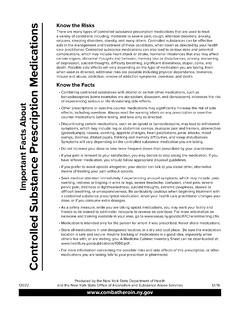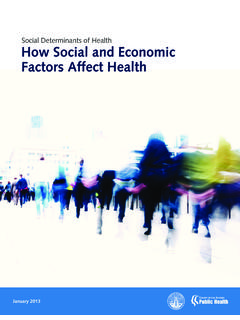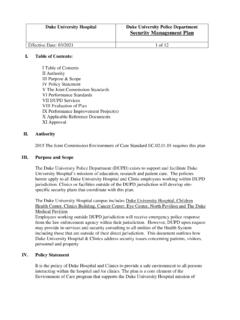Transcription of Older Employees in the Workplace - Centers for Disease ...
1 Older Employees in the Workplace Issue Brief No. 1. July 2012. Background Advances in public health and medicine and improvements in technology have allowed Americans to increase not only their health , but life expectancy as well, from age 70 to 78. over the past 50 , 2 This improvement in life expectancy and health brings with it the willingness, and sometimes the financial need, for Older adults to work beyond the traditional retirement age of 65 years. Researchers have found that as Baby Boomers . people born from 1946 to 1964, age, they are prolonging their employment and careers, resulting in an increase in the number of Older workers in the Workplace . Who are Older Employees ? The question is not easy to define and there is no consensus defining who is an Older worker. Different agencies and organizations use a broad spectrum of ages, ranging from 40 65 years of age, to determine when they consider an employee an Older worker.
2 For example, The Department of Labor considers an Older worker to be someone aged 55 years or Older , whereas the Age Discrimination in Employment Act of 1967 provides protection for anyone in the Workplace Older than 40 years. Where are Older workers employed and what hours do they work? Older workers are found in every type of industry, including blue-collar, white-collar, and service industries, with slightly more in white collar industries. Within these industries, Older workers are represented in every job category and Until the year 2000, workers 65 years of age or Older held more part-time than full-time Workers Aged 65 years and Older by Work Schedule, 1977 2007. positions. In 1995, 56% of Older workers age 65. years or Older held part-time positions and 44%. Percentage of Employment held full-time positions.
3 Since then, there has been a steady increase in full-time positions for these Older workers, growing to a complete reversal in 2007, where 56% held full-time positions and 44% In 2011, this gap widened further when 77% of workers aged 55. years or Older held full-time employment while 23% held part-time Issue Why is the aging population staying in the workforce? By 2030, the number of people aged 65 years or Older in the United States is projected to double to 72 million adults representing 20%. of the total The qualifying age to receive full Social Security retirement benefits has been increasing incrementally since 1998 and will reach 67 years by As a result, the average age of the workforce has slowly risen and is projected to continue rising. This increase in workers' age has been attributed to overall health of the Older population, the change in eligibility for Social Security retirement benefits, the general economic climate, the need for health insurance, and the availability and design of employer- sponsored benefits, typically transferring greater responsibility to the retiree ( , from defined benefits plans and pensions to defined contribution plans and 401Ks).
4 1,4,7 Aside from this, a cross-sectional study completed by Susann Rohwedder and Robert J. Willis in 2010 shows that Employees who retire in their early sixties have diminished cognitive ability compared with those who retire at or after retirement age due to decreased engagement in mental exercises in the work environment before retirement and the home environment after This could also be a contributing factor to Older workers deciding to stay in the workforce. National Center for Chronic Disease Prevention and health Promotion Division of Population health What are employers' perceptions of Older workers? Percentage Increase in Employment by Age and Sex, 1977 - 2007. Overall, employers have positive views of Older 16 Years or Older 59. workers. Prior studies revealed that employers 65 Years or Older 101. report that Older workers have greater knowledge of the job tasks they perform than their younger colleagues, willingly learn new tasks quickly, Men, 65 Years or Older 75.
5 Age bring wisdom and resilience to work, and are able Women, 65 Years or Older 147. to keep up with the physical demands their jobs require. All of these elements are widely believed 65 69 Years 85. to positively affect A study by Dee 70 74 Years 98. Edington and others show greater costs are 75 Years or Older 172. associated with increasing health risk more than increasing Despite these findings, the 0 50 100 150 200. perception still exists among employers that Percentage of Increase Older workers are more costly than younger Source: Bureau of Labor Statistics workers because of higher absenteeism, higher wages, higher pensions, and increased use of health care and other ,11 Regardless of these perceptions, most employers do not find these limitations sufficient to offset the appeal in hiring or keeping Older workers in the What barriers do Older Employees face in the Workplace ?
6 Although employers have an overall positive view of Older workers and are willing to employ them, these workers still face barriers that hinder their employment prospects, including11: Reduced employment opportunities. Those who are returning to the workforce or making a career change later in life find it harder to maintain salary and benefit levels comparable to their previous employment, because fewer options are available. Decreased training participation. When compared to younger workers, Older workers are less likely to participate in Workplace training activities (35 hours per year for younger workers versus 9. hours per year for Older workers).11 Contributing factors to this disparity potentially originate from perceptions of both employers and Employees that prolonged tenure means greater level of Workplace knowledge or lack of interest.
7 Employees also may feel diminished support from management to participate in training opportunities. Increased discrimination. Employer anxiety around salary and benefit costs have driven some to avoid interviewing and hiring Older workers, even though evidence suggests it would not cut Workplace productivity or earnings to employ them. Increased disparities in health . A decline in overall health , such as developing cardiovascular Disease , has been shown to be associated with increasing age. This could result in Workplace limitations that intimidate and discourage both the employer and the Older employee. More challenging Workplace conditions. When the need arises for Older workers to care for aging family members or slowly transition out of the Workplace , they may be confronted with inflexible work hours. Flexible work conditions, such as unconventional work schedules or the ability to telecommute, are important for employers to consider when employing Older workers.
8 2. Opportunity As stated previously, the overall health of the Older population has improved over time because of increased awareness of the basic mechanisms of human health and Disease and better self-management. Despite these improvements, a direct relationship still exists between increasing age, increasing health risks , and the associated medical costs. For this reason, employers should not only provide opportunities in areas such as scheduling and training, but they also should consider programs in the worksite for Older workers to engage in healthy lifestyle activities. These programs are crucial to the health , longevity, engagement and productivity of Older workers and helps employers by decreasing costs, increasing their return on investment, decreasing the companies' benefit expenses, and improving the image of the company in the Why should employers care?
9 Employers pay a large share of costs associated with health risks and chronic Disease . The risk and numbers of chronic conditions a person lives with increases as we age. Age itself is a health risk factor, but one that you cannot modify. Modifiable risk behaviors ( , tobacco use, physical inactivity, and poor nutrition) can be targeted and prevented. It is never too late to address both modifiable individual risk factors and environmental risk factors like exposure to toxic chemicals or extreme noise. health risks appears to have more effect on employer costs than simply getting Older . For example, in the table shown above, a person who is 65 years of age with low health risk has lower annual medical costs than a person who is 45 years of age with medium health risk. 10. Beyond direct medical costs, which most employers focus on, indirect productivity-related costs of poor health , such as worker's compensation and short-term disability, can be 2 to 3 times higher than direct medical costs.
10 Because of this, the Workplace is an excellent place to make an impact and reduce Employees ' risks . Worksite health programs can make a difference in Employees '. health and quality of life. Some of the benefits associated with worksite health programs are12. Improved employee health and well-being. Lower employee health risks and improved health status can lower health care costs. Ability to affect workers' compensation-related expenses through integrating safety and health promotion. Reduction in absenteeism and presenteeism (the measurable extent to which health symptoms, conditions, and diseases adversely affect the work productivity of individuals who choose to remain at work13) and increased productivity. 3. Kaiser Family Foundation and health Research & Educational Trust Employer health Benefits 2011 Annual Survey21.















